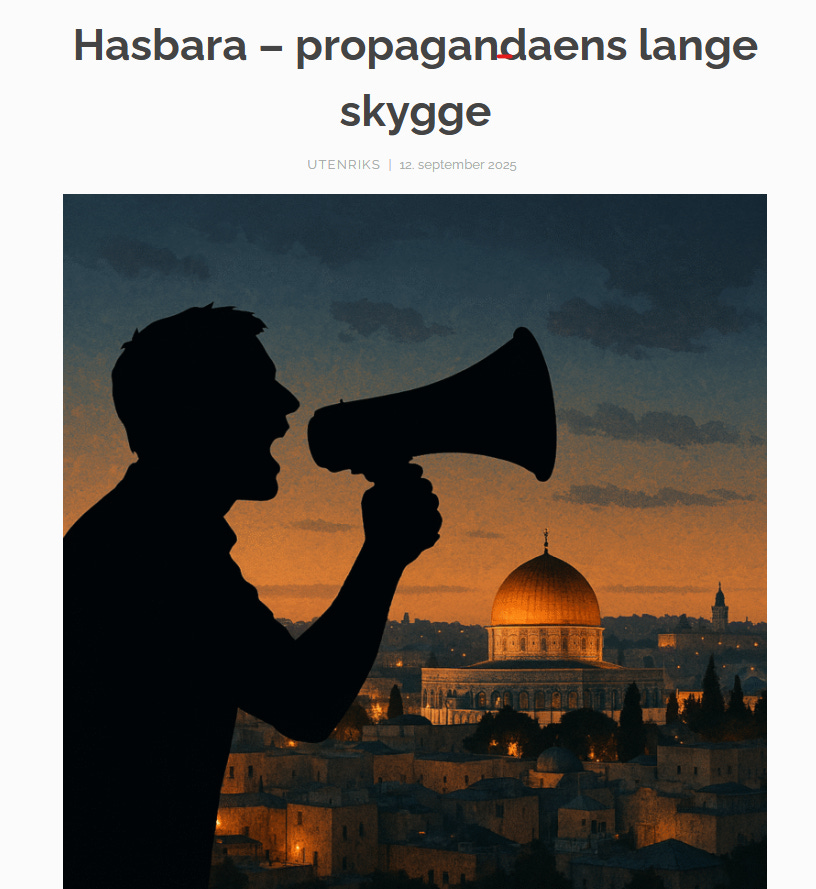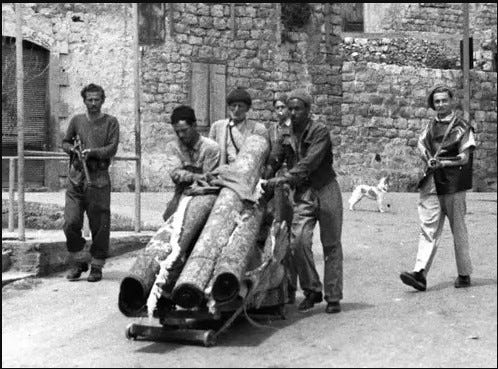Hasbara: The Long Shadow of Propaganda
When the bombs began to fall over Gaza in the autumn of 2023, a parallel battle was taking place on a completely different battlefield: public opinion.
The term hasbara, Hebrew for “explanation,” is central to understanding how the state of Israel has used communication and propaganda as a political weapon for decades. Hasbara is not a neutral term; it denotes an entire infrastructure of PR strategies, talking points, and campaigns aimed at legitimising Israel’s policies and weakening critical perspectives.
Hasbara has its roots in the 1940s and 1950s, when the young state of Israel had to defend its legitimacy internationally. Since then, it has evolved into a professionalised communications machine, financed and coordinated from government offices, but also supported by a network of embassies, lobby organisations, think tanks, and diaspora actors.
In the 1980s, dedicated units were established to train ambassadors in hasbara, and with the internet and social media, its reach has become global. The goal has never been merely to explain or defend Israel’s cause, but to shape the very framework for how the conflict is discussed: which words are used, which images dominate, and which questions are left unanswered.
Narratives Take Root
When we talk about the Gaza war in 2023, it is striking how quickly certain narratives appear and are repeated in Western media, including in Norway. These narratives take hold, even when later disproven.
Examples include stories of decapitated babies, babies burned in ovens, misfired Palestinian rockets hitting hospitals, or extensive tunnel systems under hospitals.
Many of these claims turned out to be false or undocumented, but before corrections arrived, they had already shaped public opinion and provided political cover for military actions. The effect can still be seen in discussions on social media, where the claims persist.
Other persistent myths are connected to history:
That Palestine was “a land without people” before 1948, popularised with the slogan “a land without a people for a people without a land.”
That Israel’s wars are always defensive, regardless of who attacks first or which territories are annexed.
That criticism of Israel’s policies is inherently antisemitic, deterring politicians, journalists, and academics from speaking out.
This is what hasbara is: not necessarily producing outright lies, but planting a particular image early on, knowing it will stick. Psychological research shows that first impressions often endure, even when later contradicted.
Infrastructure for Influence
Hasbara operates on multiple levels:
State coordination: Israel’s Ministry of Foreign Affairs produces talking points, videos, and media packages shared with diplomats and supporters.
Lobby and diaspora: Organisations in the U.S. and Europe monitor media coverage and respond quickly to criticism, often with letter-writing campaigns, threats of ad boycotts, or accusations of bias.
Digital campaigns: In 2023, thousands of accounts on X/Twitter and TikTok coordinated messages, often to overwhelm critics or create the impression of broad support.
Academia and culture: Sponsoring conferences, festivals, and exchange programmes provides a softer image of the state while building loyalty among influential audiences.
In Norway, traces of this can be seen whenever critical voices against Israeli policy are met with accusations of antisemitism, or when Norwegian media quickly relay Israeli talking points while Palestinian sources are considered less credible. Norwegian politicians have repeatedly defended Israel’s “right to self-defence,” but almost never the Palestinians’ equivalent right.
Limitations
Still, hasbara does not have unlimited power. During the Gaza war in 2023, the visual images of destroyed neighbourhoods and dead children were so strong that they broke through the control of communication. Propaganda loses its effect when reality becomes too strong to be overshadowed by narratives.
Digital developments have also changed the balance of power. Previously, states could more effectively control the flow of information through established media, but today individuals with a smartphone can reach millions. When activists, journalists, and humanitarian organisations share live reports from the ground, maintaining a one-sided narrative becomes more difficult.
Another factor is trust. When stories repeatedly turn out to be false or exaggerated, the credibility of the sender weakens. Audiences gradually learn to question the information, which can trigger a backlash where the communication is seen as cynical or manipulative.
Hasbara can also create polarisation. The moment audiences notice a voice trying to control the debate, they may turn away or seek alternative sources.
The War Against Journalists
Another crucial aspect is who gets access to information. In the Gaza war, independent journalists were denied access under the pretext of security concerns. This creates an information vacuum in which Israeli state talking points dominate.
Claims of security concerns are weakened when Israel invites selected influencers who uncritically relay IDF talking points, often to a young, global audience. This shift from traditional journalism to influencer-driven propaganda illustrates how communication adapts to the digital age while attempting to maintain narrative control.
This occurs alongside a war against journalists themselves. Multiple media houses and international organisations have documented a disproportionately high number of journalist deaths in Gaza and that media offices have been targeted by bombings. Evidence suggests this is not accidental but part of a deliberate strategy to reduce independent reporting from the ground. Journalists bringing images and stories that contradict the Israeli line are themselves seen as a threat to narrative control.
Another example is how the created famine and malnutrition in Gaza are discussed. While the UN and humanitarian organisations document children and adults dying from hunger due to the blockade, Israeli spokespersons have claimed the deaths are actually due to underlying illnesses. This can also be seen in Norway. The point, however, is that people with underlying conditions also starve when food is unavailable, and the most vulnerable are often hit harder and faster. Many in Gaza have already lost their lives to the hunger crisis, but this is dismissed or even ridiculed. Human suffering is thus turned into a rhetorical device, a form of dehumanisation where tragedy and pain are neither recognised nor acknowledged.
The Power of Language
Connections can also be drawn to George Orwell’s 1984, where language itself becomes a tool of power. When words and concepts are redefined, such as “defensive war” regardless of who attacks, “antisemitism” applied to legitimate criticism, or “terrorist” applied to all opponents, it resembles Orwell’s concept of newspeak. This use of language to redefine reality is seen in practice: when journalists are targeted for murder, or famine is explained away, words and narratives are used to shape what can be recognised as legitimate and what can be minimised or ignored.
The purpose is the same: to limit which thoughts can be expressed at all, thereby shaping the framework of reality.
Hasbara is therefore powerful, but not omnipotent. It increasingly faces strong counter-narratives, and digitalisation has given civil society, grassroots movements, and independent journalists new tools to challenge established narratives.
Even here, hasbara appears in the form of delegitimisation. Protests are portrayed as pro-Hamas, and calls for a ceasefire are depicted as naive or anti-Jewish.
Analysing hasbara is not about denying Jews’ right to safety or downplaying antisemitism. On the contrary, a real fight against antisemitism requires that the term not be misused to shield a state’s policies from criticism. When everything is reduced to PR and propaganda, it is ultimately civilians, in Gaza, the West Bank, Israel, and the diaspora, who pay the price.
For readers, journalists, and politicians in Norway, this means we must be more critical of our sources. We must recognise the strategies, question the myths, and dare to let other voices be heard.
Hasbara is not just a phenomenon “over there.” It is present here, in how we think about Gaza, Palestinians, war, and peace. The clearer we see it, the harder it becomes to accept that reality should be explained away.
The article is originally in Norwegian, and posted on the website direktedebatt.no and can be read in Norwegian here. Translated through AI and not rewrtitten in English.
All articles on Diaspora Dialogue are free to read for one year from publication. If you’ve enjoyed this piece and would like to support my work, you can do so by subscribing, or by buying me a coffee. Thank you for reading and being part of the dialogue!





Even the term 'Gaza war' is incorrect. War implies a battle between two equal countries. Israel is an occupying entity that controls Gaza, and Gaza doesn't have an army.
I've been paying attention to geopolitical issues for awhile now and here are some sources I trust that you might find useful. https://dianavaneyk.substack.com/p/geopolitially-context-is-everything
Thanks for posting Shoaib.